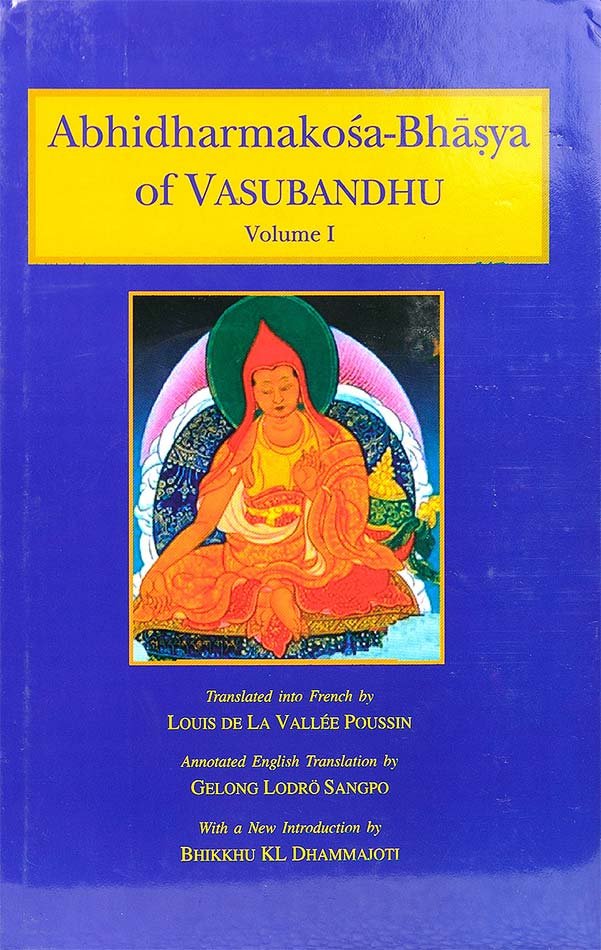Abhidharmakosa-bhasya of Vasubandhu
author: Gelong Lodro Sangpo
edition: 2012, Munshiram Manoharlal Publishers
pages: 2972
language: English
ISBN-13: 9788120836075
Topic: Mahayana
Summary: This is the annoted English translation of the Abhidharmakosa-Bhasya: The Treasury of the Abhidharma and its (Auto) Commentary, consisting of four volumes. The original work was written by Vasubandhu in the 4th century. The Sanskrit title of the text is Abhidharmakośabhāṣya (अभिधर्मकोशभाष्य)
Buy now with free shipping!
Source: exoticindiaart.com
Introduction:
Vasubandhu’s abhidharmakosa-Bhasya (ca. 380-390), besides its culminating achievement in streamlining the overall structure of the exposition of the preceding Abhidharma manuals, is unmatched by any of the preceding manuals in respect of its comprehensiveness-incororating all important vaibhasika doctrines since the time of Abhidharma-mahavibhasa-of its excellent skill in definition and elucidation, and of its ability to clarify the difficult points involved in doctrinal disputations.Added to these qualities is its great value as a brilliant critique and insightful re-evaluation of all the fundamental Sarvastivada doctrines developed up to its time.
Since its appearance, it has been used as a standard textbook for the understanding of not only the Abhidharma doctrines but all the fundamental Buddhist doctrines in general
Translated into Chinese by Paramartha in 563 A.D. and by Hsuan-tsang in 651-654 A.D., Hsuan-tsang’s Abhidharmakosa Bhasya was hailed as the “book of Intelligence”. In China, Japan and the Far-eat, too, the Kosa has generally been highly treasured as a textbook of fundamental importance for Buddhist studies.
Vasubandh’s Brilliant critique of the doctrines of the Vaibhasika was answered by the equally brilliants amghabhadra-a contemporary staunch defender and expounder of the doctrines of Vaibhasikas-in his masterwork, the Abhidharmanyayanusara, now extant only in Hsuan-tsang’s translation(653-654A.D.).
The Sanskrit text, considered for a long time to be irremediably lost, was discovered by Rahula samkrtyaana in 1935 in the Tibetan monastery of Ngor and was published by P. Pradhan in 1967 (1st edition)
Vasubandhu (ca.350-430 A.D.) was born in Purusapura in Gandhara and is, next to Asanga (ca330-405 A.D.), his halfbrother, the most famous personage of the Yogacara school.
He originally belonged to the Sravakayana school of the Saravastivadins and had already made a name for himself through the composition of numberous treatises when the was won over to the Mahayana by Asanga, sometime in his forties
Vasubandhu counts as the great systematizer of Buddhism and is one of the six great ornaments- six great commentators of the Buddha’s teaching.
Even though in the Kosa, Vasubandhu seems to be generally partisan to the “Hinayana” Sautrantikas, he too was evidently open-minded, of which fact the osa is a testimony, and accordingly he did not seem to have become exclusively partisan to the tenets of any group as such –be it those of Hinayana-or Yoacara-sautrantika or Sarvastivada.
Available pages:
[About the author (Gelong Lodro Sangpo)]
[Preface (outline of contents)]
[Introduction (the two baskets of the Vinaya and Dharma & the first Matrkas)]
Contents of this online book (index):
The full text of the Abhidharmakosa-bhasya of Vasubandhu in English can be quickly summarized in the following table of contents. Becaue these pages are not available to read online, I would recommend you buy the book.
Chapter one: Exposition of the Elements (Dhatu-nirdesa) [link]
Chapter two: Exposition of the Faculties (Indriya-nirdesa [link]
Chapter three: Exposition of the World (Loka-nirdesa) [link]
Chapter four: Exposition of Action (Karma-nirdesa) [link]
Chapter five: Exposition of the Proclivities (Anusaya-nirdesa) [link]
A Summary of the Path by Louis de La Vallee Poussin [link]
Chapter six: Exposition of the Path and the Persons in whom the Noble Path Arises (Margapudgala-nirdesa) [link]
Chapter seven: Exposition of the Cognitions (Jnana-nirdesa) [link]
Chapter eight: Exposition of the Meditative Attainments (samapatti-nirdesa) [link]
Chapter nine: Treatise of the Refutation of the Person (Pudgalapratisedha-prakarana) [link]
